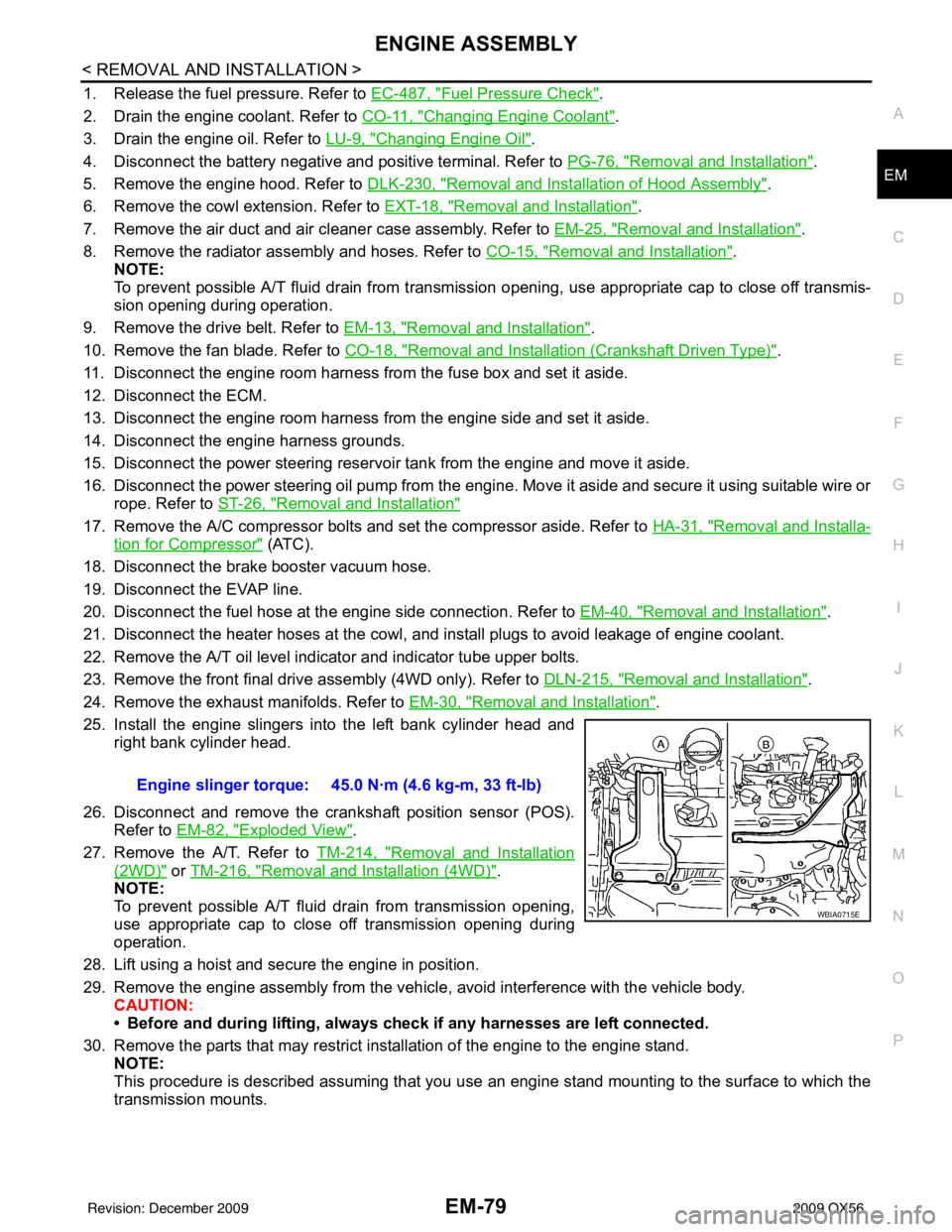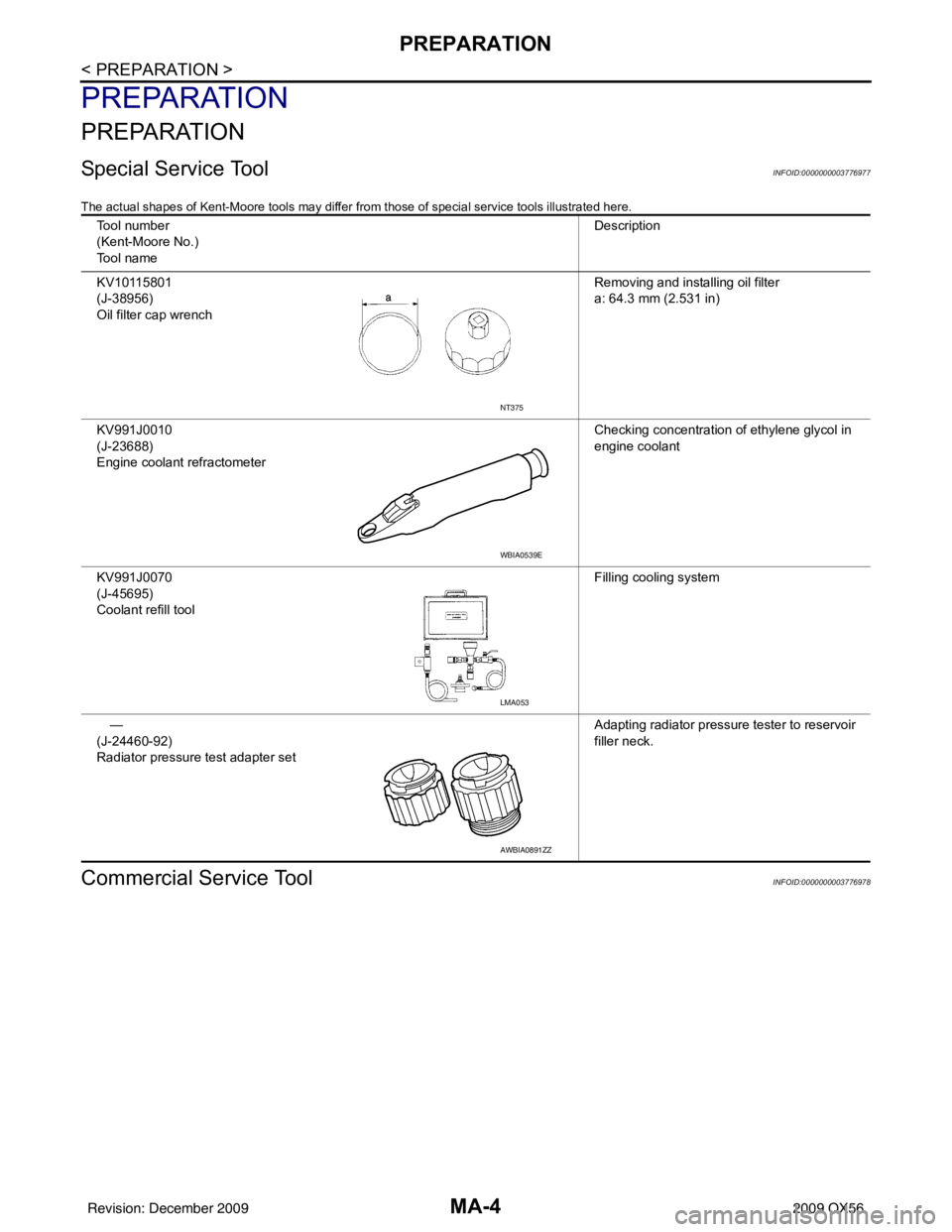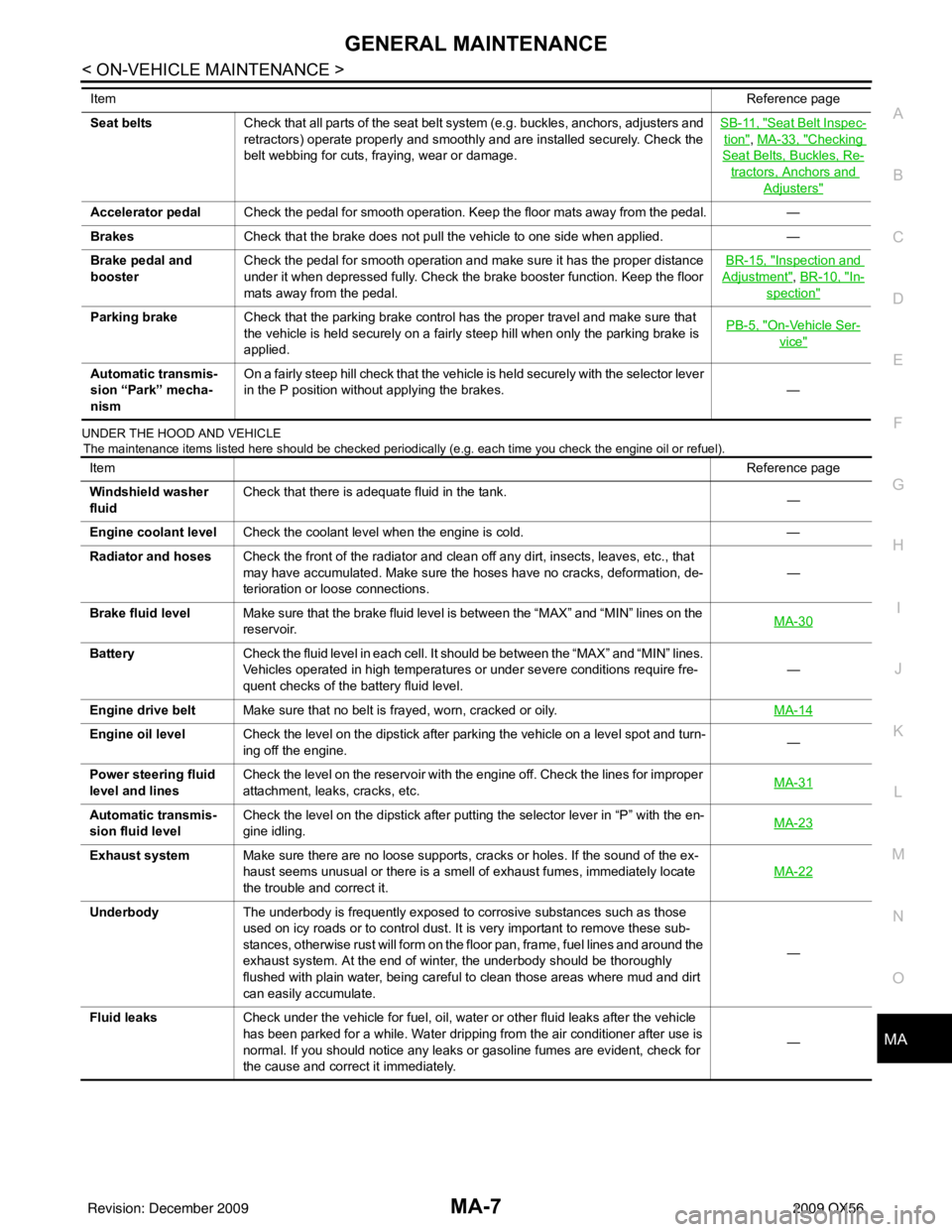2009 INFINITI QX56 coolant reservoir
[x] Cancel search: coolant reservoirPage 1353 of 4171
![INFINITI QX56 2009 Factory Service Manual
EC-26
< FUNCTION DIAGNOSIS >[VK56DE]
ENGINE CONTROL SYSTEM
1. Knock sensor (bank 1) (view with en-
gine removed) 2. Knock sensor (bank 2) (view with en-
gine removed) 3. Battery current sensor
4. Pow INFINITI QX56 2009 Factory Service Manual
EC-26
< FUNCTION DIAGNOSIS >[VK56DE]
ENGINE CONTROL SYSTEM
1. Knock sensor (bank 1) (view with en-
gine removed) 2. Knock sensor (bank 2) (view with en-
gine removed) 3. Battery current sensor
4. Pow](/manual-img/42/57031/w960_57031-1352.png)
EC-26
< FUNCTION DIAGNOSIS >[VK56DE]
ENGINE CONTROL SYSTEM
1. Knock sensor (bank 1) (view with en-
gine removed) 2. Knock sensor (bank 2) (view with en-
gine removed) 3. Battery current sensor
4. Power steering pressure sensor 5. Power steering fluid reservoir 6. Intake manifold
7. Engine coolant temperature sensor 8. Ignition coils (with power transistor) 9. Ignition coil (with power transistor)
10. Injector harness connectors (bank 2) 11. Injector harness connectors (bank 1) : Vehicle front
BBIA0384E
Revision: December 20092009 QX56
Page 1625 of 4171
![INFINITI QX56 2009 Factory Service Manual
EC-298
< COMPONENT DIAGNOSIS >[VK56DE]
P1217 ENGINE OVER TEMPERATURE
P1217 ENGINE OVER TEMPERATURE
On Board Diagn
osis LogicINFOID:0000000003771589
NOTE:
If DTC P1217 is displayed with DTC U1000 or INFINITI QX56 2009 Factory Service Manual
EC-298
< COMPONENT DIAGNOSIS >[VK56DE]
P1217 ENGINE OVER TEMPERATURE
P1217 ENGINE OVER TEMPERATURE
On Board Diagn
osis LogicINFOID:0000000003771589
NOTE:
If DTC P1217 is displayed with DTC U1000 or](/manual-img/42/57031/w960_57031-1624.png)
EC-298
< COMPONENT DIAGNOSIS >[VK56DE]
P1217 ENGINE OVER TEMPERATURE
P1217 ENGINE OVER TEMPERATURE
On Board Diagn
osis LogicINFOID:0000000003771589
NOTE:
If DTC P1217 is displayed with DTC U1000 or U1001, first perform the trouble diagnosis for DTC
U1000, U1001. Refer to EC-86
.
If DTC P1217 is displayed with DTC P0607, first pe rform the trouble diagnosis for DTC P0607. Refer
to EC-284
.
If the cooling fan or another component in the coo ling system malfunctions, engine coolant temperature will
rise.
When the engine coolant temperature reaches an abnorma lly high temperature condition, a malfunction is
indicated.
This self-diagnosis has the one trip detection logic.
CAUTION:
When a malfunction is indicated, be su re to replace the coolant. Refer to CO-11, "Changing Engine
Coolant". Also, replace the engine oil. Refer to LU-9, "Changing Engine Oil".
1. Fill radiator with coolant up to specified level with a filling speed of 2 liters per minute. Be sure to
use coolant with the proper mixture ratio. Refer to CO-10
.
2. After refilling coolant, run engine to en sure that no water-flow noise is emitted.
Overall Function CheckINFOID:0000000003771590
Use this procedure to check the overall function of the cooling fan. During this check, a DTC might not be con-
firmed.
WARNING:
Never remove the radiator cap and/or reservoir tank cap when the engine is hot. Serious burns could
be caused by high pressure fluid escaping fr om the radiator and/or reservoir tank.
Wrap a thick cloth around cap. Carefully remove the cap by turning it a quarter turn to allow built-up
pressure to escape. Then turn the cap all the way off.
WITH CONSULT-III
1. Check the coolant level in the reservoir tank and radiator. Allow engine to cool before checking coolant level.
If the coolant level in the reservoir tank and/or radiator is below
the proper range, skip the following steps and go to EC-388,
"Diagnosis Procedure".
2. Confirm whether customer filled the coolant or not. If customer
filled the coolant, skip the following steps and go to EC-388,
"Diagnosis Procedure".
3. Turn ignition switch ON.
DTC No. Trouble diagnosis name DTC detecting condition Possible cause
P1217
1217 Engine over tempera-
ture (Overheat) Cooling fan does not operate properly (Over-
heat).
Cooling fan system does not operate proper-
ly (Overheat).
Engine coolant was not added to the system using the proper filling method.
Engine coolant is not within the specified range. Harness or connectors
(The cooling fan circuit is open or short-
ed.)
Cooling fan
Cooling fan (crankshaft diven)
IPDM E/R (Cooling fan relay)
Radiator hose
Radiator
Radiator cap
Reservoir tank
Reservoir tank cap
Water pump
Thermostat
For more informat ion, refer to EC-300,
"Main 13 Causes of Overheating".
SEF621W
Revision: December 20092009 QX56
Page 1626 of 4171
![INFINITI QX56 2009 Factory Service Manual
P1217 ENGINE OVER TEMPERATUREEC-299
< COMPONENT DIAGNOSIS > [VK56DE]
C
D
E
F
G H
I
J
K L
M A
EC
NP
O
4. Perform “COOLING FAN” in “ACTIVE TEST” mode with CONSULT-III.
5. If the results are NG, INFINITI QX56 2009 Factory Service Manual
P1217 ENGINE OVER TEMPERATUREEC-299
< COMPONENT DIAGNOSIS > [VK56DE]
C
D
E
F
G H
I
J
K L
M A
EC
NP
O
4. Perform “COOLING FAN” in “ACTIVE TEST” mode with CONSULT-III.
5. If the results are NG,](/manual-img/42/57031/w960_57031-1625.png)
P1217 ENGINE OVER TEMPERATUREEC-299
< COMPONENT DIAGNOSIS > [VK56DE]
C
D
E
F
G H
I
J
K L
M A
EC
NP
O
4. Perform “COOLING FAN” in “ACTIVE TEST” mode with CONSULT-III.
5. If the results are NG, go to
EC-388, "Diagnosis Procedure"
.
WITH GST
1. Check the coolant level in the reservoir tank and radiator.
Allow engine to cool befo re checking coolant level.
If the coolant level in the reservoir tank and/or radiator is below
the proper range, skip the following steps and go to EC-388,
"Diagnosis Procedure".
2. Confirm whether customer filled the coolant or not. If customer
filled the coolant, skip the following steps and go to EC-388,
"Diagnosis Procedure".
3. Disconnect engine coolant temper ature sensor harness connec-
tor.
4. Connect 150 Ω resistor to engine coolant temperature sensor
harness connector.
5. Start engine and make sure that cooling fan operates. CAUTION:
Be careful not to overheat engine.
6. If NG, go to EC-388, "Diagnosis Procedure"
.
Diagnosis ProcedureINFOID:0000000003771591
1.CHECK COOLING FAN (CRANKSHAFT DRIVEN) OPERATION
1. Start engine and let it idle.
2. Make sure that cooling fan (crankshaft driven) operates normally.
OK or NG
OK (With CONSULT-III)>>GO TO 2.
OK (Without CONSULT-III)>>GO TO 3.
NG >> Check cooling fan (crankshaft driven). Refer to CO-18, "Removal and Installation (Crankshaft
Driven Type)".
2.CHECK COOLING FAN MOTOR OPERATION
With CONSULT-III
1. Start engine and let it idle.
2. Select “COOLING FAN” in “A CTIVE TEST” mode with CONSULT-III.
3. Make sure that cooling fan operates.
OK or NG
OK >> GO TO 4.
NG >> Check cooling fan control ci rcuit. (Go to "PROCEDURE A".)
3.CHECK COOLING FAN MOTOR OPERATION
Without CONSULT-III
1. Disconnect engine coolant temperature sensor harness connector.
2. Connect 150 Ω resistor to engine coolant temperature sensor harness connector.
3. Start engine and let it idle.
SEF621W
SEF882V
Revision: December 20092009 QX56
Page 1627 of 4171
![INFINITI QX56 2009 Factory Service Manual
EC-300
< COMPONENT DIAGNOSIS >[VK56DE]
P1217 ENGINE OVER TEMPERATURE
4. Make sure that cooling fan operates.
OK or NG
OK >> GO TO 4.
NG >> Check cooling fan control circuit. (Go to "PROCEDURE
A".)
4. INFINITI QX56 2009 Factory Service Manual
EC-300
< COMPONENT DIAGNOSIS >[VK56DE]
P1217 ENGINE OVER TEMPERATURE
4. Make sure that cooling fan operates.
OK or NG
OK >> GO TO 4.
NG >> Check cooling fan control circuit. (Go to "PROCEDURE
A".)
4.](/manual-img/42/57031/w960_57031-1626.png)
EC-300
< COMPONENT DIAGNOSIS >[VK56DE]
P1217 ENGINE OVER TEMPERATURE
4. Make sure that cooling fan operates.
OK or NG
OK >> GO TO 4.
NG >> Check cooling fan control circuit. (Go to "PROCEDURE
A".)
4.CHECK COOLING SYSTEM FOR LEAK
Refer to CO-10, "Inspection"
.
OK or NG
OK >> GO TO 5.
NG >> Check the following for leak. Hose
Radiator
Radiator cap
Water pump
Reservoir tank
5.CHECK COMPONENT PARTS
Check the following.
RESERVOIR TANK CAP (Refer to CO-10, "Inspection"
.)
Thermostat. (Refer to CO-22, "Removal and Installation"
.)
Engine coolant temperature sensor. (Refer to EC-122, "Component Inspection"
.)
OK or NG
OK >> GO TO 7.
NG >> Replace malfunctioning component.
6.CHECK MAIN 13 CAUSES
If the cause cannot be isolated, go to EC-300, "Main 13 Causes of Overheating"
.
>> INSPECTION END
Main 13 Causes of OverheatingINFOID:0000000003771592
SEF882V
Engine Step Inspection item Equipment Standard Reference page
OFF 1 Blocked radiator Blocked condenser
Blocked radiator grille
Blocked bumper Visual No blocking —
2 Coolant mixture Coolant tester 50 - 50% coolant mixture CO-10
3 Coolant level Visual Coolant up to MAX level in
reservoir tank and radiator
filler neckCO-11, "Changing Engine
Coolant"
4 Reservoir tank cap Pre
ssure tester 95 - 125 kPa
(0.97 - 1.28 kg/cm2, 14 -
18 psi) (Limit) CO-10, "Inspection"
ON*25 Coolant leaks Visual No leaks
CO-10, "Inspection"
ON*26 Thermostat Touch the upper and
lower radiator hosesBoth hoses should be hot
CO-22, "Removal and In-
stallation"
ON*17 Cooling fan CONSULT-III Operating See trouble diagnosis for
DTC P1217 (EC-36
).
Revision: December 20092009 QX56
Page 1628 of 4171
![INFINITI QX56 2009 Factory Service Manual
P1217 ENGINE OVER TEMPERATUREEC-301
< COMPONENT DIAGNOSIS > [VK56DE]
C
D
E
F
G H
I
J
K L
M A
EC
NP
O
*1: Turn the ignition switch ON.
*2: Engine running at 3,000 rpm for 10 minutes.
*3: Drive at 90 k INFINITI QX56 2009 Factory Service Manual
P1217 ENGINE OVER TEMPERATUREEC-301
< COMPONENT DIAGNOSIS > [VK56DE]
C
D
E
F
G H
I
J
K L
M A
EC
NP
O
*1: Turn the ignition switch ON.
*2: Engine running at 3,000 rpm for 10 minutes.
*3: Drive at 90 k](/manual-img/42/57031/w960_57031-1627.png)
P1217 ENGINE OVER TEMPERATUREEC-301
< COMPONENT DIAGNOSIS > [VK56DE]
C
D
E
F
G H
I
J
K L
M A
EC
NP
O
*1: Turn the ignition switch ON.
*2: Engine running at 3,000 rpm for 10 minutes.
*3: Drive at 90 km/h (55 MPH) for 30 minutes and then let idle for 10 minutes.
*4: After 60 minutes of cool down time.
For more information, refer to
CO-8, "Troubleshooting Chart"
.
OFF 8 Combustion gas leak Color checker chemical
tester 4 Gas analyzerNegative —
ON*
39 Coolant temperature gauge Visual Gauge less than 3/4 when
driving —
Coolant overflow to res- ervoir tank Visual No overflow during driving
and idling CO-11, "Changing Engine
Coolant"
OFF*410 Coolant return from res-
ervoir tank to radiator Visual Should be initial level in
reservoir tank CO-11, "Changing Engine
Coolant"
OFF 12 Cylinder head Straight gauge feeler
gauge0.1 mm (0.004 in) Maxi-
mum distortion (warping) EM-72, "Inspection After
Disassembly"
13 Cylinder block and pis-
tons Visual No scuffing on cylinder
walls or piston EM-90, "Inspection After
Disassembly"
Engine Step Inspection item Equipment Standard Reference page
Revision: December 20092009 QX56
Page 1902 of 4171

ENGINE ASSEMBLYEM-79
< REMOVAL AND INSTALLATION >
C
DE
F
G H
I
J
K L
M A
EM
NP
O
1. Release the fuel pressure. Refer to
EC-487, "Fuel Pressure Check".
2. Drain the engine coolant. Refer to CO-11, "
Changing Engine Coolant".
3. Drain the engine oil. Refer to LU-9, "
Changing Engine Oil".
4. Disconnect the battery negative and positive terminal. Refer to PG-76, "
Removal and Installation".
5. Remove the engine hood. Refer to DLK-230, "
Removal and Installation of Hood Assembly".
6. Remove the cowl extension. Refer to EXT-18, "
Removal and Installation".
7. Remove the air duct and air cleaner case assembly. Refer to EM-25, "
Removal and Installation".
8. Remove the radiator assembly and hoses. Refer to CO-15, "
Removal and Installation".
NOTE:
To prevent possible A/T fluid drain from transmissi on opening, use appropriate cap to close off transmis-
sion opening during operation.
9. Remove the drive belt. Refer to EM-13, "
Removal and Installation".
10. Remove the fan blade. Refer to CO-18, "
Removal and Installation (Crankshaft Driven Type)".
11. Disconnect the engine room harness from the fuse box and set it aside.
12. Disconnect the ECM.
13. Disconnect the engine room harness from the engine side and set it aside.
14. Disconnect the engine harness grounds.
15. Disconnect the power steering reservoir t ank from the engine and move it aside.
16. Disconnect the power steering oil pump from the engine. Move it aside and secure it using suitable wire or rope. Refer to ST-26, "
Removal and Installation"
17. Remove the A/C compressor bolts and set the compressor aside. Refer to HA-31, "Removal and Installa-
tion for Compressor" (ATC).
18. Disconnect the brake booster vacuum hose.
19. Disconnect the EVAP line.
20. Disconnect the fuel hose at the engine side connection. Refer to EM-40, "
Removal and Installation".
21. Disconnect the heater hoses at the cowl, and in stall plugs to avoid leakage of engine coolant.
22. Remove the A/T oil level indicator and indicator tube upper bolts.
23. Remove the front final drive assembly (4WD only). Refer to DLN-215, "
Removal and Installation".
24. Remove the exhaust manifolds. Refer to EM-30, "
Removal and Installation".
25. Install the engine slingers into the left bank cylinder head and right bank cylinder head.
26. Disconnect and remove the crankshaft position sensor (POS). Refer to EM-82, "
Exploded View".
27. Remove the A/T. Refer to TM-214, "
Removal and Installation
(2WD)" or TM-216, "Removal and Installation (4WD)".
NOTE:
To prevent possible A/T fluid drain from transmission opening,
use appropriate cap to close off transmission opening during
operation.
28. Lift using a hoist and secure the engine in position.
29. Remove the engine assembly from the vehicl e, avoid interference with the vehicle body.
CAUTION:
• Before and during lifting, always check if any harnesses are left connected.
30. Remove the parts that may restrict installation of the engine to the engine stand. NOTE:
This procedure is described assuming that you use an engine stand mounting to the surface to which the
transmission mounts. Engine slinger torque: 45.0 N·m (4.6 kg-m, 33 ft-lb)
WBIA0715E
Revision: December 20092009 QX56
Page 2677 of 4171

MA-4
< PREPARATION >
PREPARATION
PREPARATION
PREPARATION
Special Service ToolINFOID:0000000003776977
The actual shapes of Kent-Moore tools may differ from those of special service tools illustrated here.
Commercial Service ToolINFOID:0000000003776978
Tool number
(Kent-Moore No.)
Tool name Description
KV10115801
(J-38956)
Oil filter cap wrench Removing and installing oil filter
a: 64.3 mm (2.531 in)
KV991J0010
(J-23688)
Engine coolant refractometer Checking concentration of ethylene glycol in
engine coolant
KV991J0070
(J-45695)
Coolant refill tool Filling cooling system
—
(J-24460-92)
Radiator pressure test adapter set Adapting radiator pressure tester to reservoir
filler neck.
NT375
WBIA0539E
LMA053
AWBIA0891ZZ
Revision: December 20092009 QX56
Page 2680 of 4171

GENERAL MAINTENANCEMA-7
< ON-VEHICLE MAINTENANCE >
C
DE
F
G H
I
J
K L
M B
MA
N
O A
UNDER THE HOOD AND VEHICLE
The maintenance items listed here should be checked periodically (e.g. each time you check the engine oil or refuel).
Seat beltsCheck that all parts of the seat belt system (e.g. buckles, anchors, adjusters and
retractors) operate properly and smoothly and are installed securely. Check the
belt webbing for cuts, fraying, wear or damage. SB-11, "Seat Belt Inspec-
tion", MA-33, "Checking
Seat Belts, Buckles, Re-
tractors, Anchors and
Adjusters"
Accelerator pedal
Check the pedal for smooth operation. Keep the floor mats away from the pedal. —
Brakes Check that the brake does not pull the vehicle to one side when applied. —
Brake pedal and
booster Check the pedal for smooth operation and make sure it has the proper distance
under it when depressed fully. Check the brake booster function. Keep the floor
mats away from the pedal. BR-15, "
Inspection and
Adjustment", BR-10, "In-
spection"
Parking brake
Check that the parking brake control has the proper travel and make sure that
the vehicle is held securely on a fairly steep hill when only the parking brake is
applied. PB-5, "On-Vehicle Ser-
vice"
Automatic transmis-
sion “Park” mecha-
nismOn a fairly steep hill check that the vehicle is held securely with the selector lever
in the P position without applying the brakes.
—
Item
Reference page
Item Reference page
Windshield washer
fluid Check that there is adequate fluid in the tank.
—
Engine coolant level Check the coolant level when the engine is cold. —
Radiator and hoses Check the front of the radiator and clean off any dirt, insects, leaves, etc., that
may have accumulated. Make sure the hoses have no cracks, deformation, de-
terioration or loose connections. —
Brake fluid level Make sure that the brake fluid level is between the “MAX” and “MIN” lines on the
reservoir. MA-30
Battery
Check the fluid level in each cell. It should be between the “MAX” and “MIN” lines.
Vehicles operated in high temperatures or under severe conditions require fre-
quent checks of the battery fluid level. —
Engine drive belt Make sure that no belt is frayed, worn, cracked or oily. MA-14
Engine oil levelCheck the level on the dipstick after parking the vehicle on a level spot and turn-
ing off the engine. —
Power steering fluid
level and lines Check the level on the reservoir with the engine off. Check the lines for improper
attachment, leaks, cracks, etc.
MA-31
Automatic transmis-
sion fluid levelCheck the level on the dipstick after putting the selector lever in “P” with the en-
gine idling.
MA-23
Exhaust system
Make sure there are no loose supports, cracks or holes. If the sound of the ex-
haust seems unusual or there is a smell of exhaust fumes, immediately locate
the trouble and correct it. MA-22
Underbody
The underbody is frequently exposed to corrosive substances such as those
used on icy roads or to control dust. It is very important to remove these sub-
stances, otherwise rust will form on the floor pan, frame, fuel lines and around the
exhaust system. At the end of winter, the underbody should be thoroughly
flushed with plain water, being careful to clean those areas where mud and dirt
can easily accumulate. —
Fluid leaks Check under the vehicle for fuel, oil, water or other fluid leaks after the vehicle
has been parked for a while. Water dripping from the air conditioner after use is
normal. If you should notice any leaks or gasoline fumes are evident, check for
the cause and correct it immediately. —
Revision: December 20092009 QX56